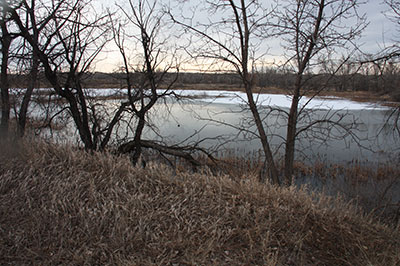Sounds of ice
The science behind eerie noises from frozen lakes
Feb 15, 2012 - by Staff
Feb 15, 2012 - by Staff
Margaret LeMone | February 16, 2012 • As I write this, the Boulder winds sound indistinguishable from a car driving by our house. But it is another sound—the sound of ice—that is the inspiration for this post. The ice on ponds and lakes.
We were hiking east of Boulder Reservoir (map location) in search of common mergansers (a type of large duck) when we heard the first sound, an eerie, low-frequency noise like that from the longest organ pipe. Repeated, irregular. We couldn’t figure out what it was for a while, but then we realized it was coming from the lake, which was nearly covered with a large sheet of slightly-shifting ice [that looked] thick enough to walk on.
The second sound of ice we heard was on a hike at Barr Lake, an hour east of Boulder, close to Brighton and Denver International Airport (map location). We were again looking for birds, this time on the south side of the lake where there was a large patch of open water and thin, breaking sheets of ice near the south shore. Instead of the low-register, eerie sound, we heard a high-pitched sound—“tinkly,” like little bells, to me, but more “crinkly” to my husband Peter, who likened the sound to what one hears when wadding up thin but stiff plastic wrapping. When I described this sound to NCAR scientist Charlie Knight, who has heard it before, he likened it to the tinkling sound of wind chimes.

A partially covered (and silent) lake at Sawhill Ponds. Not all of the icy lakes have made sounds on our recent hikes. (Photo by Peggy LeMone.)
The cause? For the larger lake with thick ice, we thought at first that flexing and cracking of the ice due to expansion/contraction related to temperature changes makes the sound. Charlie, who has spent a lot of time around ice not only at Sawhill Ponds northeast of Boulder (map location), but also in the Arctic and Antarctic, likens the cracking of ice to a sound more like gun shots. He wasn’t sure of the origin of what we heard at the reservoir. For now, we’ve settled on the source being flexing of the ice, recalling the distinctive sound one gets when flexing a sheet of metal.
For the very thin ice near the shores of Barr Lake, we could see cracking caused by wave action on the thin film of ice, suggesting that the tinkling sound could be related to the tiny sheets breaking. In this case, the sound emitters were quite small and thus have a higher frequency. The day was not particularly windy, but on other days, when there is wind, Charlie suggests that the ice pieces bumping into each other would produce a similar sound.
While living on the Arctic ice sheet, hundreds of miles from land, Charlie had ample time to listen. He describes one night illuminated only by stars and flashlights:
My own, most memorable experience with sounds from ice is from standing right next to a forming pressure ridge, at the edge of the camp ARLIS I [Arctic Research Laboratory Ice Station I]. The pressure ridge was forming quite slowly, but inexorably, with the ice breaking up and blocks getting pushed up into the ridge, up to about six feet above the relatively flat level of the ice, which was around five feet thick. It was a whole cacophony of squeeks, groanings, and pops, but very slow.
But it’s not only ice on lakes that makes interesting sounds. During long winter walks years ago, a friend and I noted that the pitch of the “crunch” your boot makes when walking in snow changes with temperature. Near freezing, the snow gives the expected “crunch, crunch.” But, as the temperature dips to well below 0°F (-20°C), the sound almost turns to “cheep, cheep”—the crunching sound, but a few octaves higher. Though I have sought an explanation, I have never found one that fully explained the higher pitch.
>>>
Margaret "Peggy" LeMone spends much of her free time exploring ways to investigate the world of weather as a citizen scientist. An NCAR senior scientist emerita, she served as the 2010 president of the American Meteorological Society.